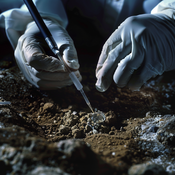Alexandrium: Difference between revisions
| Line 60: | Line 60: | ||
==Extraction== | ==Extraction== | ||
[[File:AlexandriumMining1730AN.jpg|250px|thumb|right|An Aleandrium open-pit mine outside [[Piriya]], [[Alduria]]. {{AN| | [[File:AlexandriumMining1730AN.jpg|250px|thumb|right|An Aleandrium open-pit mine outside [[Piriya]], [[Alduria]]. {{AN|1731}}.]] | ||
===Current Methods=== | ===Current Methods=== | ||
The extraction of Alexandrium, given its unique genesis at nuclear blast sites in [[Eura]], presents both a technological challenge and an environmental concern. Current methods include: | The extraction of Alexandrium, given its unique genesis at nuclear blast sites in [[Eura]], presents both a technological challenge and an environmental concern. Current methods include: | ||
Revision as of 02:09, 20 February 2024

|
This article or section is a work in progress. The information below may be incomplete, outdated, or subject to change. |
Alexandrium is a novel element discovered in the Region of Alduria, within the Federation of Nouvelle Alexandrie. Identified in 1729 AN by a distinguished scientific team from the Royal University of Parap, this element arose from the unique geological and nuclear conditions prevalent in the aftermath of the Babkhan Holocaust on the continent of Eura. The creation of Alexandrium under such severe conditions has resulted in its unparalleled properties, heralding a potential revolution in energy production, materials science, and beyond.
Characteristics
Physical Properties
Alexandrium is noted for its prismatic luster and crystalline structures that form complex geometric patterns, capable of refracting light into a spectrum of vibrant colors. This element's density is significantly higher than traditional heavy metals, including lead, adding to its distinctiveness. Possessing an exceptionally high melting point, Alexandrium can withstand extreme heat and resist corrosion, which makes it a prime candidate for use in challenging environments such as aerospace, deep-sea exploration, and high-temperature reactors. Its energy density is extraordinary and it showcases exceptional stability when exposed to radiation, with potential applications in energy storage and generation that could redefine modern technology.
Chemical Properties and Compounds
Chemically, Alexandrium forms superconductive compounds at temperatures that are considerably higher than those of current superconductors. This trait indicates a breakthrough in electrical energy transmission and the potential to dramatically reduce current energy losses. The compounds of Alexandrium are also noted for their remarkable chemical stability, suggesting their suitability for creating durable materials and protective coatings that can endure extreme environmental conditions.
Isotopes
The isotopic variety of Alexandrium includes several isotopes, each with distinct half-lives and potential applications. The most stable isotope, Alexandrium-239, possesses a half-life exceeding 10,000 years, positioning it as a virtually inexhaustible energy source for applications requiring long-term energy autonomy, such as interstellar travel. Its stability also offers intriguing possibilities for sustainable energy and advanced medical treatments leveraging its controlled radioactive properties.
Discovery
The revelation of Alexandrium on the periodic table is attributed to the leading-edge explorations conducted by the scientific coalition at the Royal University of Parap in conjunction with the National Research and Development Corporation. In the year 1729 AN, leveraging the sophisticated techniques of spectroscopic analysis and employing the high-energy particle collision method, the collaborative research teams achieved a breakthrough. They meticulously analyzed soil samples collected from the radiation-impacted zones of present-day Alduria, Nouvelle Alexandrie, which still bears the scars of nuclear fallout caused by the Babkhan Holocaust in 1589 AN. It was within these samples that they identified the unique atomic signature of Alexandrium, an element previously unseen and unrecorded in scientific literature.
The discovery process involved isolating the element from a complex matrix of soil components altered by intense radioactive exposure. The research teams utilized a series of high-resolution spectral lines to pinpoint the presence of Alexandrium amidst a cacophony of signals arising from other elements and compounds in the soil. The definitive identification was corroborated through the application of high-energy particle collisions, which allowed for the observation of Alexandrium's characteristic decay patterns and atomic interactions.
Confirmed deposits
The discovery of Alexandrium has led to the identification of significant deposits across Eura, with Alduria alone boasting substantial amounts. The most prominent deposits have been located in the following areas:
| Location | Nation | Updated Deposit (metric tons) | Estimated Value of Entire Deposit |
|---|---|---|---|
| Piriya, Alduria | 80,000 | €137,840,000,000 | |
| Sana'Ri, Alduria | 203,765 | €351,273,495,000 | |
| Bathshahr, Alduria | 296,109 | €510,243,927,000 | |
| Susa, Alduria | 188,123 | €324,247,929,000 | |
| Alcala, Alduria | 564,424 | €972,578,392,000 | |
| Ajinkeliç, Alduria | 90,000 | €155,070,000,000 | |
| Aqabah, Molivadia | 250,000 | €430,750,000,000 | |
| Nivardom, Molivadia | 130,000 | €223,990,000,000 | |
| Zinjibar, Norasht | 338,036 | €582,394,012,000 |
The total proven and confirmed deposits across these locations now amount to 2,041,457 metric tons of Alexandrium. This revision significantly increases the previous estimates[1] and underscores the vast economic potential these deposits represent for Nouvelle Alexandrie, Constancia, and the Suren Confederacy.
The enormous value of these deposits, calculated at the benchmark price of €1,723 per gram, highlights the rarity and significance of Alexandrium.
Potential Applications
Energy
Alexandrium's high energy density and superconductive properties are poised to revolutionize the energy sector. Its use in power generation could lead to highly efficient and clean energy sources, substantially reducing the carbon footprint.
Materials
The physical and chemical stability of Alexandrium compounds make them ideal for creating materials capable of withstanding extreme conditions. These advanced materials can find applications in aerospace, military, and industrial sectors, driving innovation and creating new markets.
Medicine
The isotopic variety of Alexandrium, particularly Alexandrium-239, has potential medical applications, from cancer treatment to advanced diagnostic techniques. Its controlled radioactive properties could offer safer and more effective treatment options for a range of medical conditions.
Extraction
Current Methods
The extraction of Alexandrium, given its unique genesis at nuclear blast sites in Eura, presents both a technological challenge and an environmental concern. Current methods include:
- Open-pit mining: Utilized in areas where Alexandrium deposits are near the surface, this method involves removing large quantities of earth, which can lead to significant landscape alteration and habitat destruction.
- Underground mining: For deeper deposits, tunneling is required, which carries risks of subsurface instability and increases the potential for radiation exposure among workers.
- Heap leaching: This process involves piling crushed ore and applying a leaching solution to extract Alexandrium. While effective, the chemical runoff poses a risk of soil and water contamination.
Given the presence of Alexandrium in areas affected by nuclear fallout, the extraction process is further complicated by elevated radiation levels, necessitating specialized protective measures to ensure worker safety and prevent environmental degradation.
Environmental and Safety Considerations
The extraction sites' inherent radioactivity requires stringent safety protocols. Continuous monitoring for radiation levels, the use of robotic extraction to minimize human exposure, and proper containment of radioactive dust are essential components of the current extraction process.
Research and Development
Recognizing the need for more sustainable extraction methods, the Royal University of Parap, in collaboration with the National Research and Development Corporation, is leading research to develop new techniques that consider Alexandrium's unique properties. Current research directions include:
- Bioleaching: Investigating the use of microorganisms to biologically extract Alexandrium, reducing the need for harmful chemicals.
- Electromagnetic separation: Exploring methods to separate Alexandrium from ore using its superconductive properties, potentially reducing environmental impact.
- Phytomining: The possibility of using hyperaccumulator plants to absorb Alexandrium from the soil is being studied as a way to reduce the need for mechanical extraction.
Controversies
Environmental Concerns
The extraction of Alexandrium has sparked significant environmental concerns due to the potential for ecological disruption and contamination. The risk of soil degradation, water table depletion, and biodiversity loss has prompted environmental groups to call for stringent regulatory frameworks. The potential for Alexandrium particles to contaminate air and water sources is a subject of intense scrutiny, with environmentalists urging for comprehensive impact assessments before the expansion of mining operations. The development of cleaner extraction technologies is seen as imperative to minimize the ecological footprint of these operations.
Health Concerns
Health concerns primarily revolve around the radioactive properties of Alexandrium. Given its origins in nuclear blast sites, the element poses a significant risk of radiation exposure. Workers involved in the extraction and processing of Alexandrium require protective measures beyond standard protocols. These include specialized radiation suits, the implementation of decontamination chambers, and rigorous health surveillance programs to detect any early signs of radiation sickness or long-term health effects. The public health implications extend to communities surrounding Alexandrium processing facilities. There is an emphasis on ensuring that these facilities have robust containment measures to prevent any form of radioactive leak or spill that could affect the local population. Health authorities are tasked with developing emergency response strategies in the event of accidental exposure, including evacuation plans, medical treatment protocols, and environmental remediation efforts.
Conflict minerals
From the earliest discovery of the range of potential applications for Alexandrium, combined with observed scarcity and high price by weight value, the mineral swiftly began to become of interest to the underground criminal syndicates of the Confederacy of the Dispossessed.
As news of the mind boggling estimated value of deposits of Alexandrium discovered in Zinjibar spread, the Dispossessed veterans of the Norasht campaign were roused to renewed efforts to regain that port. An imperfect awareness of the processes entailed in the formation of Alexandrium also stirred an interest amongst the insurgents and criminal elements. Norasht Ostan had hardly been spared during the days of atomic horror visited upon Eura. The eponymous capital of the satrapy, being already a persistent warzone, was another place where the Dispossessed could hope to uncover similar deposits.
Regulation and Policy
The emergence of Alexandrium as a vital resource has prompted calls for robust regulatory frameworks to govern its extraction, use, and trade.
Economic Impact
Future Research
Significant research efforts are underway to fully understand and exploit Alexandrium's unique properties.
See also
- Economy of Nouvelle Alexandrie
- Royal University of Parap
- National Research and Development Corporation


